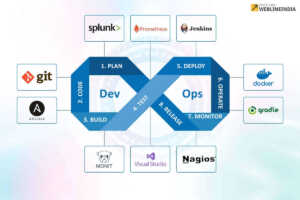Today, we are in the “post cloud.” The need to manage your own systems is becoming more and more rare. Virtual machines have allowed businesses to create a one-size-fits all environment that can be added onto or spun off at will.
This is where the world of IT operations is headed in 2022 (and beyond). Here are five ways this new world will be different from the one we are in now
DevOps 
DevOps is a growing philosophy in the world of IT operations, and if you aren’t familiar with it yet, then it should be your mission to educate yourself.
What is DevOps? It’s a world view that combines development and operations into a cohesive unit working towards a common goal: business value. In other words, instead of having two teams, a dev team and an ops team, you have a single agile or DevOps team that knows how to deliver new features from start to finish.
In 2022 the world of IT operations will be vastly different from today. In five years time we can expect to see more industry trends shifting towards this future state, as well as some paradigm changes along the way.
Complete Automation – One of the first things that comes to mind when you imagine DevOps or agile is automation. It’s no secret that it’s able to speed up the provisioning of a cloud VM in seconds, or can help you build a whole web app in a matter of minutes. While automation is nothing new, in 2022 it will be even more prevalent. In fact, by this point most companies have fully automated their production environments using tools such as Puppet and Chef.
NoOps – Another buzzword that’s often heard in the DevOps world is NoOps, which stands for “no operations.” While this might sound like a strange idea at first, it does actually make sense. Rather than having IT operations people to manually perform tasks all day long, many low-level routine jobs are automated by software. You can think of this as “operations-less operations.”
Big Data Ops – While most people are familiar with big data in terms of analytics, there is more to this term than meets the eye. In 2022, some companies will begin to think about using big data in the context of IT operations. In other words, they’ll try to find patterns and trends across all their production data in order to improve future IT workflows.
Digital Transformations 
Digital Transformation continues to change how businesses operate. In 2022, technology will play a major role in the ways that we work and live – firstly by making our business processes more efficient and secondly by allowing us to be productive from almost anywhere at any time. Two vital transformations in this sector are edge computing and open source software.
Edge computing is one way to reduce latency, where response times are near-instantaneous, even on the mobile web. For example, if you wanted to interact with an object on your mobile phone or watch that was connected to an IoT sensor device at high speed, it would need to be done via a local network connection to the device itself.
In 2022, we will see Edge Computing used in business more and more as a way for companies to streamline their processes by using the Cloud only when it’s required. This will give them a competitive advantage over others who are still relying on the legacy model of remote Cloud providers.
Open source software has always had a strong following in some circles, but more and more companies are adopting it to make their software development workflows faster, more flexible and cost-effective. In 2022, we will see a number of high impact developments from this area – a more widespread recognition of the benefits gained by Open Source projects, more commitment to existing open source projects and more companies or communities of individuals taking on the responsibility of supporting an open source project.
AIOps
AIOps is a term that has been created to describe the growing convergence of IT operations and technology-specific application performance management (APM). Although it may sound like a buzzword, AIOps is here to stay because operational efficiency needs are only increasing. By 2022, many companies will have adopted AIOps solutions as standard practice.
The acronym “AIOps” stands for ” Artificial Intelligence for IT Operations.” Put another way, if machine learning is about using algorithms to detect patterns in data, then AIOps uses machine learning to detect patterns in data generated by an organization’s apps, services and infrastructure.
AIOps applies machines’ capabilities in pattern recognition to the massive amounts of technical data that are generated by IT operations. This is already proving to be extremely valuable for companies looking to improve their IT operations strategy, as well as those who have already adopted IT automation and orchestration tools.
The premise of AIOps is simple. With the rise of machine learning, there’s now enough computing power available in a small package to make it possible to apply machine learning algorithms to the huge volumes of data coming from IT operations. The value in this is that these algorithms can detect performance problems, flag “normal” activity patterns and even automate certain tasks before humans are aware that an issue has taken place.
Cloud Native Strategies 
By 2022, most enterprises will have a majority of their infrastructures running in the cloud. With so many applications being run over the internet, there is no surprise that security concerns will arise as it becomes harder to monitor and maintain thousands of servers from a single central location. In addition, organizations are now able to utilize new tools for monitoring that are widely available in the cloud. One of the major ways companies will shift toward becoming cloud-native is through adopting IT monitoring tools like DataDog, which enable companies to aggregate logs and monitor their infrastructures.
Great strides have been made over the past decade with cloud native technologies, and that is expected to continue. Already, companies like Netflix run their websites almost entirely on AWS (Amazon Web Services) without virtualization or traditional hardware. The next wave of movement will be towards containers for these workloads – but microservices are required first.
The modern day equivalent of running workloads in virtual machines, containers are the next step towards cloud native. Even with microservices at scale, orchestration is required to handle dependency management , software defined networks (SDN) for traffic control, and proper scheduling . Orchestration is perhaps the most challenging aspect of moving to a modern architecture that uses containers often with thousands of them running simultaneously. Finally, developers will come to expect all these elements as a package deal when buying into a new cloud native environment.
In 2022 and beyond, it’s all about how well your IT operations can align with business objectives. Otherwise, you’re going to be left behind. Check out Bayshore Interactives social media accounts to stay in touch with the latest technology news.

